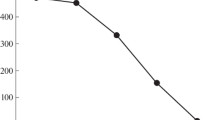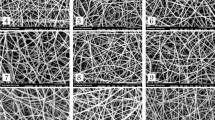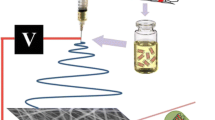Abstract
Cancer is one of the most fatal diseases in the world. Chemotherapy and radiation therapy are conventional cancer treatments affecting healthy tissues and also have many side effects. Drug delivery systems based on nanofibers can be used as cancer drug carrier with the least side effects. 5FU is one of the most common medicines for many types of cancer. In this study, PCL/PVP core–shell nanofibers containing MWCNTs were performed as 5FU carrier, which was loaded in core of these nanofibers. FESEM images showed all these core–shell nanofibers are uniform and the average diameter was 300–400 nm. There was no interaction between components of nanofibers, and the presence of 5FU in nanofibers was confirmed. The presence of MWCNTs loaded in shell improved the tensile properties. The degradability of nanofibers was investigated, and it was improved by increasing PVP in nanofibers. The morphology change in nanofibers was investigated by FESEM images after degradation. The release behavior of nanofibers was studied. These nanofibers had sustained and prolonged release, and the optimum sample in which 85% of drug released after 528 h was used for cytotoxicity test. The drug release mechanism was modeled by various mathematical models and followed Fick's law. MTT assay on HeLa cell line showed that cell cytotoxicity of 5FU loaded nanofibers was 50.35% after 72 h. The non-toxicity of carrier and efficacy of the drug loaded nanofibers mat on cervical cancer cell line were confirmed. This drug delivery system has the potential to perform as post-surgical anticancer drug delivery system.











Similar content being viewed by others
References
Siegel RL, Miller KD, Jemal A (2020) Cancer statistics. CA Cancer J Clin 70(1):7–30
Lewandowska U, Gorlach S, Owczarek K, Hrabec E, Szewczyk K (2014) Synergistic interactions between anticancer chemotherapeutics and phenolic compounds and anticancer synergy between polyphenols. Adv Hyg Exp Med 68
Zhang N, Yin Y, Xu SJ, Chen WS (2008) 5-Fluorouracil: mechanisms of resistance and reversal strategies. Molecules 13(8):1551–1569
Steichen SD, Caldorera-Moore M, Peppas NA (2013) A review of current nanoparticle and targeting moieties for the delivery of cancer therapeutics. Eur J Pharmaceut Sci 48(3):416–427
Prabaharan M (2015) Chitosan-based nanoparticles for tumor-targeted drug delivery. Int J Biol Macromol 72:1313–1322
Hu X, Liu S, Zhou G, Huang Y, Xie Z, Jing X (2014) Electrospinning of polymeric nanofibers for drug delivery applications. J Control Release 185:12–21
Grem JL (2000) 5-Fluorouracil: forty-plus and still ticking. A review of its preclinical and clinical development. Investig New Drugs 18(4):299–313
Rejinold NS, Muthunarayanan M, Chennazhi KP, Nair SV, Jayakumar R (2011) 5-Fluorouracil loaded fibrinogen nanoparticles for cancer drug delivery applications. Int J Biol Macromol 48(1):98–105
Okuda T, Tominaga K, Kidoaki S (2010) Time-programmed dual release formulation by multilayered drug-loaded nanofiber meshes. J Control Release 143(2):258–264
Ajnai G, Chiu A, Kan T, Cheng CC, Tsai TH, Chang J (2014) Trends of gold nanoparticle-based drug delivery system in cancer therapy. J Exp Clin Med 6(6):172–178
Hadjianfar M, Semnani D, Varshosaz J (2018) Polycaprolactone/chitosan blend nanofibers loaded by 5-fluorouracil: An approach to anticancer drug delivery system. Polym Adv Technol 29(12):2972–2981
Gao Y, Bai Y, Zhao D, Chang MW, Ahmad Z, Li JS (2015) Tuning microparticle porosity during single needle electrospraying synthesis via a non-solvent-based physicochemical approach. Polymers 7(12):2701–2710
Zamani M, Prabhakaran MP, Ramakrishna S (2013) Advances in drug delivery via electrospun and electrosprayed nanomaterials. Int J Nanomed 8:2997
Torres-Martínez EJ, Cornejo Bravo JM, Serrano Medina A, Pérez González GL, Villarreal Gómez LJ (2018) A summary of electrospun nanofibers as drug delivery system: Drugs loaded and biopolymers used as matrices. Curr Drug Deliv 15(10):1360–1374
Zeng J, Yang L, Liang Q, Zhang X, Guan H, Xu X, Jing X (2005) Influence of the drug compatibility with polymer solution on the release kinetics of electrospun fiber formulation. J Control Release 105(1–2):43–51
Absar S, Khan M, Edwards K, Neumann J (2015) Investigation of synthesis and processing of cellulose, cellulose acetate and poly (ethylene oxide) nanofibers incorporating anti-cancer/tumor drug cis-diammineplatinum (II) dichloride using electrospinning techniques. J Polym Eng 35(9):867–878
Absar S, Khan M, Edwards K, Calamas D (2014) Electrospinning of cisplatin-loaded cellulose nanofibers for cancer drug delivery. In: ASME 2014 international mechanical engineering congress and exposition. American Society of Mechanical Engineers Digital Collection
Martins AF, Vlcek J, Wigmosta T, Hedayati M, Reynolds MM, Popat KC, Kipper MJ (2020) Chitosan/iota-carrageenan and chitosan/pectin polyelectrolyte multilayer scaffolds with antiadhesive and bactericidal properties. Appl Surf Sci 502:144282
Baker SR, Banerjee S, Bonin K, Guthold M (2016) Determining the mechanical properties of electrospun poly-ε-caprolactone (PCL) nanofibers using AFM and a novel fiber anchoring technique. Mater Sci Eng C 59:203–212
Niiyama E, Uto K, Ebara M (2019) Electrospun PCL-PCL polyblend nanofibers with high-and low-molecular weight for controlled degradation. Chem Lett 48(7):623–626
Cheng Z, Teoh SH (2004) Surface modification of ultra thin poly (ε-caprolactone) films using acrylic acid and collagen. Biomaterials 25(11):1991–2001
Chong EJ, Phan TT, Lim IJ, Zhang YZ, Bay BH, Ramakrishna S, Lim CT (2007) Evaluation of electrospun PCL/gelatin nanofibrous scaffold for wound healing and layered dermal reconstitution. Acta Biomater 3(3):321–330
Vernosfaderani FR, Semnani D (2018) Manufacturing and optimization the nanofibres tissue of poly (N-vinyl-2-pyrrolidone)-poly (e-caprolactone) shell/poly (N-vinyl-2-pyrrolidone)-amphotericin b core for controlled drug release system. Fibers Polym 19(3):620–626
Kim GM, Le KHT, Giannitelli SM, Lee YJ, Rainer A, Trombetta M (2013) Electrospinning of PCL/PVP blends for tissue engineering scaffolds. J Mater Sci Mater Med 24(6):1425–1442
Cruz DMG, Coutinho DF, Mano JF, Ribelles JLG, Sanchez MS (2009) Physical interactions in macroporous scaffolds based on poly (ɛ-caprolactone)/chitosan semi-interpenetrating polymer networks. Polymer 50(9):2058–2064
Qian W, Yu DG, Li Y, Liao YZ, Wang X, Wang L (2014) Dual drug release electrospun core-shell nanofibers with tunable dose in the second phase. Int J Mol Sci 15(1):774–786
Saraf A, Baggett LS, Raphael RM, Kasper FK, Mikos AG (2010) Regulated non-viral gene delivery from coaxial electrospun fiber mesh scaffolds. J Controll Release 143(1):95–103
Lee CH, Hung KC, Hsieh MJ, Chang SH, Juang JH, Hsieh IC, Liu SJ (2020) Core-shell insulin-loaded nanofibrous scaffolds for repairing diabetic wounds. Nanomed Nanotechnol Biol Med 24:102123
Liao IC, Chen S, Liu JB, Leong KW (2009) Sustained viral gene delivery through core-shell fibers. J Controll Release 139(1):48–55
Sill TJ, von Recum HA (2008) Electrospinning: applications in drug delivery and tissue engineering. Biomaterials 29(13):1989–2006
Iqbal S, Rashid MH, Arbab AS, Khan M (2017) Encapsulation of anticancer drugs (5-fluorouracil and paclitaxel) into polycaprolactone (PCL) nanofibers and in vitro testing for sustained and targeted therapy. J Biomed Nanotechnol 13(4):355–366
Yu H, Yang P, Jia Y, Zhang Y, Ye Q, Zeng S (2016) Regulation of biphasic drug release behavior by graphene oxide in polyvinyl pyrrolidone/poly (ε-caprolactone) core/sheath nanofiber mats. Coll Surf B Biointerfaces 146:63–69
Zhu LF, Zheng Y, Fan J, Yao Y, Ahmad Z, Chang MW (2019) A novel core-shell nanofiber drug delivery system intended for the synergistic treatment of melanoma. European Journal of Pharmaceutical Sciences 137:105002
Kaviannasab E, Semnani D, Khorasani SN, Varshosaz J, Khalili S, Ghahreman F (2019) Core-shell nanofibers of poly (ε–caprolactone) and Polyvinylpyrrolidone for drug delivery system. Mater Res Exp 6(11):115015
Wang B, Chen X, Ahmad Z, Huang J, Chang MW (2019) 3D electrohydrodynamic printing of highly aligned dual-core graphene composite matrices. Carbon 153:285–297
Songsurang K, Praphairaksit N, Siraleartmukul K, Muangsin N (2011) Electrospray fabrication of doxorubicin-chitosan-tripolyphosphate nanoparticles for delivery of doxorubicin. Arch Pharm Res 34(4):583
Gao Y, Zhao D, Chang MW, Ahmad Z, Li X, Suo H, Li JS (2015) Morphology control of electrosprayed core–shell particles via collection media variation. Mater Lett 146:59–64
Moon SI, Jin F, Lee CJ, Tsutsumi S, Hyon SH (2005) Novel carbon nanotube/poly (l-lactic acid) nanocomposites; their modulus, thermal stability, and electrical conductivity. Macromol Symp Wiley, Weinheim 224(1):287–296
Elhissi A, Ahmed W, Hassan IU, Dhanak V, D’Emanuele A (2012) Carbon nanotubes in cancer therapy and drug delivery. J Drug Deliv 2012:837327. https://doi.org/10.1155/2012/837327
Lamastra FR, Puglia D, Monti M, Vella A, Peponi L, Kenny JM, Nanni F (2012) Poly (ε-caprolactone) reinforced with fibres of poly (methyl methacrylate) loaded with multiwall carbon nanotubes or graphene nanoplatelets. Chem Eng J 195:140–148
Meng ZX, Zheng W, Li L, Zheng YF (2010) Fabrication and characterization of three-dimensional nanofiber membrance of PCL–MWCNTs by electrospinning. Mater Sci Eng C 30(7):1014–1021
Hadjianfar M, Semnani D, Varshosaz J (2019) An investigation on polycaprolactone/chitosan/Fe3O4 nanofibrous composite used for hyperthermia. Polym Adv Technol 30(11):2729–2741
ASTM F (2004) 1635–04–standart test method for in vitro degradation testing of hydrolytically degradable polymer resins and fabricated forms for surgical implants. American Society for Testing and Materials International, West Conshohocken, PA
Arifin DY, Lee LY, Wang CH (2006) Mathematical modeling and simulation of drug release from microspheres: Implications to drug delivery systems. Adv Drug Deliv Rev 58(12–13):1274–1325
Dash S, Murthy PN, Nath L, Chowdhury P (2010) Kinetic modeling on drug release from controlled drug delivery systems. Acta Poloniae Pharmaceutica 67(3):217–23
Hu J, Zeng F, Wei J, Chen Y, Chen Y (2014) Novel controlled drug delivery system for multiple drugs based on electrospun nanofibers containing nanomicelles. J Biomater Sci Polym Ed 25(3):257–268
Chiu LCM, Ho TS, Wong EYL, Ooi VE (2006) Ethyl acetate extract of Patrinia scabiosaefolia downregulates anti-apoptotic Bcl-2/Bcl-XL expression, and induces apoptosis in human breast carcinoma MCF-7 cells independent of caspase-9 activation. J Ethnopharmacol 105(1–2):263–268
Berridge MV, Herst PM, Tan AS (2005) Tetrazolium dyes as tools in cell biology: new insights into their cellular reduction. Biotechnol Annu Rev 11:127–152
Huang ZM, Zhang YZ, Ramakrishna S, Lim CT (2004) Electrospinning and mechanical characterization of gelatin nanofibers. Polymer 45(15):5361–5368
Liu LQ, Tasis D, Prato M, Wagner HD (2007) Tensile mechanics of electrospun multiwalled nanotube/poly (methyl methacrylate) nanofibers. Adv Mater 19(9):1228–1233
Jeong JS, Moon JS, Jeon SY, Park JH, Alegaonkar PS, Yoo JB (2007) Mechanical properties of electrospun PVA/MWNTs composite nanofibers. Thin Solid Films 515(12):5136–5141
Moniruzzaman M, Chattopadhyay J, Billups WE, Winey KI (2007) Tuning the mechanical properties of SWNT/nylon 6, 10 composites with flexible spacers at the interface. Nano Lett 7(5):1178–1185
Yao ZC, Jin LJ, Ahmad Z, Huang J, Chang MW, Li JS (2017) Ganoderma lucidum polysaccharide loaded sodium alginate micro-particles prepared via electrospraying in controlled deposition environments. Int J Pharmaceut 524(1–2):148–158
Zhou W, Lu P, Sun L, Ji C, Dong J (2012) Diffusion and binding of 5-fluorouracil in non-ionic hydrogels with interpolymer complexation. Int J Pharmaceut 431(1–2):53–60
Author information
Authors and Affiliations
Corresponding author
Ethics declarations
Conflict of interest
There is no conflict of interest declared.
Additional information
Publisher's Note
Springer Nature remains neutral with regard to jurisdictional claims in published maps and institutional affiliations.
Rights and permissions
About this article
Cite this article
Nasari, M., Semnani, D., Hadjianfar, M. et al. Poly (ε-caprolactone)/poly (N-vinyl-2-pyrrolidone) core–shell nanofibers loaded by multi-walled carbon nanotubes and 5-fluorouracil: an anticancer drug delivery system. J Mater Sci 55, 10185–10201 (2020). https://doi.org/10.1007/s10853-020-04784-3
Received:
Accepted:
Published:
Issue Date:
DOI: https://doi.org/10.1007/s10853-020-04784-3




